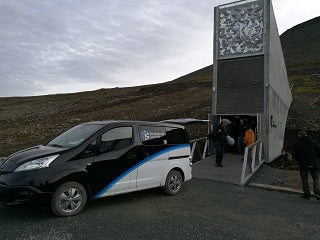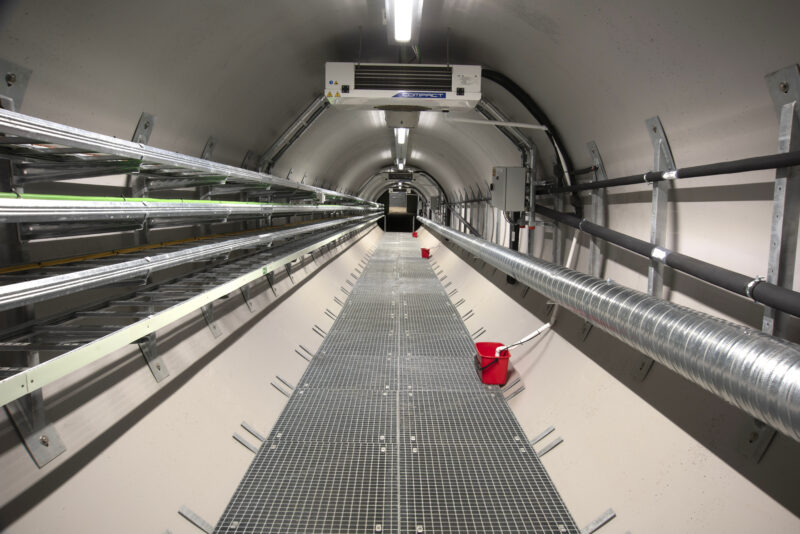The “Doomsday” Seed Vault, also known as the Svalbard Global Seed Vault, is a secure facility located on a remote island in Norway. Its purpose is to preserve the world’s plant biodiversity by storing seeds from crop plants, wild relatives, and other plant species in case of a global catastrophe. The vault is designed to withstand natural disasters, climate change, and other threats that could lead to the loss of critical genetic resources. The seed vault has now introduced a new way to experience its unique facility – a virtual reality tour.

The virtual tour was launched earlier in March, 2023. Moreover, its free for all and doesn’t need any signing up. Just hit the link here and buckle up to enjoy the VR experience of the ‘Doomsday’ vault right from your home: https://virtualtourcompany.co.uk/GlobalSeedVault/
Inside the Doomsday Vault
The entrance to the vault is a long, sloping tunnel that leads into a large, cold, and dry room that is carved into the side of a mountain. The room is designed to keep the seeds frozen at a temperature of -18°C, which is the ideal temperature for long-term storage. The vault is built to withstand earthquakes, floods, and other natural disasters, and is located far enough above sea level to be safe from rising sea levels caused by global warming.
There are 3 seed vault chambers inside, that you’ll be able to check out in the VR. Inside the vault chambers, there are rows upon rows of shelves, which are filled with boxes of seeds. Each box contains a different type of seed, and each seed is carefully labeled and cataloged so that it can be easily located and retrieved if needed. The vault can hold up to 4.5 million seed samples, making it the largest seed bank in the world.

The vault currently houses more than 1.1 million different seed kinds from practically every nation on earth. But doesn’t contain any seed from Bangladesh. A very sad news for Bangladesh. It means the crops, fruits, flowers and all the medicinal endemic plants of Bangladesh are in the hands of natural disaster. One extreme calamity and all the endemic plants will be wiped out from the earth.
How Seed Deposits Work
- The depositor and the Norwegian Ministry of Agriculture and Food sign an agreement, which is available here.
- In compliance with the Vault’s regulations, the seeds are sealed inside airtight aluminum bags.
- Details about each sample are sent to NordGen through email by the depositor. This is used for managing vaults and disseminating information to the general public via the Seed Portal website. According to NordGen representatives, each time a new deposit or withdrawal is made, the database is updated.
- Samples are sent by courier, and shipping documentation is provided. The term “accession” is used to describe samples, which typically contain 500 seeds each packet.
- Pole Position Logistics transports the samples to the vault once they reach Svalbard.
- For storage management, sample withdrawals, and disposal arrangements, the depositor and NordGen stay in touch.
- All seeds are kept in “black box” storage once they have been placed. In other words, the depositing institution is the only one with the right to withdraw the funds.


Main Types of Seeds in Seed Vault
The vast majority of the seeds in the vault—444 million or 69%—are grains like rice, millet, wheat, corn, barley, etc., which is not unusual for a facility that is primarily intended as a backup for food and agriculture. Second place goes to legumes, which account for 58 million seeds or 9% of all seeds worldwide. A wide variety of approximately 6000 distinct types of fruits, vegetables, herbs, and other plants can be found in the remaining 22%.

Only 9 species account for 2/3 of the seeds of the top specified species in the vault. The first nine are:

VR Tour in Seed Vault
As you enter the Seed Vault, you’ll see the entrance tunnel leading into the mountain. The walls are covered in beautiful artwork depicting plants and seeds from around the world. As you walk through the tunnel, you’ll see the entrance to the seed storage area.

As you enter the Seed Vault, you’ll see the entrance tunnel leading into the mountain. The walls are covered in beautiful artwork depicting plants and seeds from around the world. As you walk through the tunnel, you’ll see the entrance to the seed storage area.The shelves are arranged in rows, with each shelf holding thousands of seed samples. The seeds are kept in small packages, organized by type and labeled with information about the plant species they came from.

As you move deeper into the seed storage area, you’ll see that the shelves are arranged by region, with seeds from different parts of the world kept separate from each other. You might even see some familiar plants, such as wheat, rice, or potatoes.
The “Doomsday” Seed Vault is a crucial component in preserving the world’s plant biodiversity for future generations. With the new virtual reality tour, people from all over the world can experience this unique facility and learn about the importance of seed conservation. The VR tour provides a way for individuals to explore the vault without having to travel to Norway and see the operation of the facility first hand. The tour is an excellent opportunity to educate people about the challenges of preserving biodiversity in the face of global challenges.
References
- https://svalbardi.com/blogs/news/what-seeds-are-in-the-svalbard-global-seed-vault
- https://virtualtourcompany.co.uk/GlobalSeedVault/index.html#popup_8314
- https://www.seedvault.no/our-contribution/our-purpose/
 Plantlet The Blogging Platform of Department of Botany, University of Dhaka
Plantlet The Blogging Platform of Department of Botany, University of Dhaka






Its like you read my mind You appear to know so much about this like you wrote the book in it or something I think that you can do with a few pics to drive the message home a little bit but other than that this is fantastic blog A great read Ill certainly be back